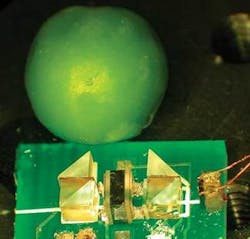SPECTROMETRY: Little laser spectrometer has applications galore

A miniature sub-Doppler-laser spectrometer developed at NIST (Boulder, CO; see www.laserfocusworld.com/articles/294625), measuring only 1 cm3 and operable at multiple wavelengths between 780 and 1590 nm, is practical for numerous frequency-stabilization applications, says the research team led by Svenja Knappe. The researchers constructed the minuscule system using MEMS technology to fabricate special millimeter-size atomic-vapor cells originally developed for use in chip-scale atomic clocks and magnetometers (see figure).1 Tiny, low-power, distributed-Bragg-reflector (DBR) lasers commonly available for spectroscopic applications in commercial electronics and communication systems also enable the reduced size of the system.
“The small size of such a spectrometer system is important for reduced power consumption over the wide range of temperatures expected for field instruments,” says researcher Leo Hollberg, “enabling its use in sub-Doppler spectroscopy as an alternative to saturated-absorption spectroscopy, polarization spectroscopy, dichroic-atomic-vapor laser lock, and selective-reflection spectroscopy.” These techniques are all essential tools in atomic-physics experiments on alkali atoms such as rubidium and cesium. In particular, these types of spectroscopy techniques focus on tightly stabilizing the laser frequency to match the atomic transition of interest.
Measurements of saturated-absorption spectra with a 795 nm distributed-Bragg-reflector pump laser resulted in linewidth and contrast of the resonances (amplitude of saturation dips compared to Doppler background) comparable to those measured in larger tabletop setups. The 1-mm-diameter laser beam, however, reduces the total power on the atoms probed and therefore reduces the signal-to-noise ratio for constant intensity through the small cell. Nevertheless, the researchers claim that a similar microfabricated sub-Doppler spectroscopy setup could be used to frequency stabilize a diode laser with a long-term instability of less than 100 kHz. Other stable optical wavelengths the miniature system could provide include 780, 895, and 852 nm.
According to Hollberg, one of the most exciting applications for the system is as a tiny field-ready frequency-stabilization system for atomic sensors such as gravimeters, gyroscopes, and accelerometers now being developed at universities, national labs, and companies like AOSense (Mountain View, CA). Adds Knappe, such a spectrometer could potentially be extended to stabilizing telecom lasers between 1540 and 1590 nm, where telecommunications devices could benefit from tighter wavelength control over longer time periods. A stabilized laser in a transistor-size electronic “can” could be useful in a plug-and-play device for applications outside physics labs, especially for nonphysicists, she adds.
The researchers believe even further size reduction could be achieved by extending MEMS technology to the optical components, rather than using off-the-shelf optics. “Even so,” says Hollberg, “the current work is a critical enabling step to bringing laser/physics systems out of the laboratory and into real-world applications.”
REFERENCE
1. S.A. Knappe et al., Optics Express 15(10) 6299 (2007).

Valerie Coffey-Rosich | Contributing Editor
Valerie Coffey-Rosich is a freelance science and technology writer and editor and a contributing editor for Laser Focus World; she previously served as an Associate Technical Editor (2000-2003) and a Senior Technical Editor (2007-2008) for Laser Focus World.
Valerie holds a BS in physics from the University of Nevada, Reno, and an MA in astronomy from Boston University. She specializes in editing and writing about optics, photonics, astronomy, and physics in academic, reference, and business-to-business publications. In addition to Laser Focus World, her work has appeared online and in print for clients such as the American Institute of Physics, American Heritage Dictionary, BioPhotonics, Encyclopedia Britannica, EuroPhotonics, the Optical Society of America, Photonics Focus, Photonics Spectra, Sky & Telescope, and many others. She is based in Palm Springs, California.